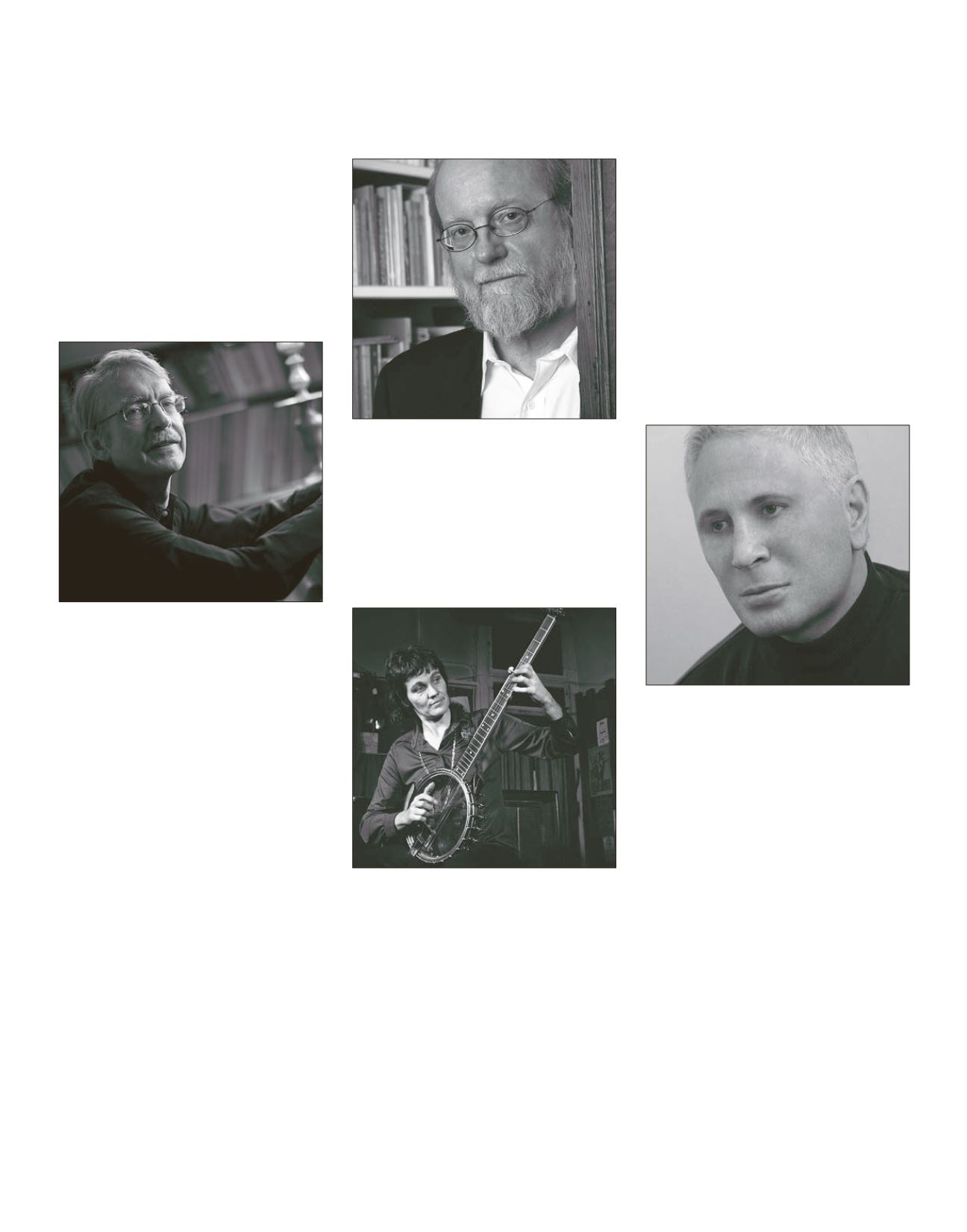
JOAN TOWER
Or like a … an Engine
Known for her vigorous and colorful music for
orchestra and smaller instrumental ensembles,
Joan Tower has so far published only one song.
Her works for the piano, her own instrument,
are much more numerous, and include two
concertos as well as a variety of solo works.
Or
like a … an Engine
she composed in
for
Ursula Oppens to a commission from the New
York classical music station WNYC for its th
birthday.
e piece is a three-minute toccata,
“somewhat like,” as she puts it, “a virtuosic Cho-
pin etude.”
JOHN HARBISON
Late Air
from
North and South
, Book
North and South
is a set of Elizabeth Bishop
songs, in two books of three that Harbison com-
posed between
and
, under a title re-
peating that of the poet’s rst collection. To open
the rst book, which he dedicated to Lorraine
Hunt Lieberson, Harbison chose a poem Bishop
had imagined as a lyric for Billie Holiday. Pop-
ular song is close, too, behind the centerpiece,
Late Air
, with its recurrent motif of an arpeg-
giated sixth chord.
e accompaniment—pro-
vided by a mixed sextet in an alternative ver-
sion—goes almost entirely in ligree, one note
at a time, except for a crucial arrival of harmony
in each stanza.
CHARLES WUORINEN
Twang
A consistently productive composer from his
late teens on, Wuorinen has in the last three de-
cades speckled his output with songs, usually to
words by distinguished living poets writing in
English: John Ashbery, Seamus Heaney, James
Fenton, and others.
Twang
(
– ), though,
sets a stanza from an earlier modern classic,
Wallace Stevens’s “ e Man with the Blue Gui-
tar.” An angular vocal line, its interval patterns
suggestive of late Stravinsky, responds in man-
ner and detail (“ orid,” “tumultuously”) to the
words, while the piano con rms the melody in a
world chromatic but incipiently tonal—or even
overtly (“impassioned choirs”).
Stevens here considers, through his title charac-
ter, the creative act. Realized in vivid imagery, a
storm is brought to life only by the blue guitar’s
“lazy, leaden twang,” and yet it does thus exist.
Wuorinen’s blue guitar must have strings to
execute the beautiful broken chord at the end.
HEDY WEST (d. 2005)
“Five Hundred Miles”
(arr. Michèle Brourman)
WILLIAM BOLCOM
People Change
from
Minicabs
Hedy West, a key gure in the US folk-mu-
sic revival that began at the start of the
s,
created her most famous song out of fragments
of lyrics and tune conveyed to her by members
of her family, who, disadvantaged and spread
across the Appalachians, had surely experienced
the poverty and displacement here given voice.
She included the number on her debut album,
released in
, but it was the cover version by
Bobby Bare, appearing later the same year, that
made it famous.
is evening we hear a new
arrangement by the singer-songwriter Michèle
Brourman.
Another Bolcom
Minicab
o ers a rueful com-
ment on all human life.
JOHN CORIGLIANO
e Passionate Shepherd to His Love
Songs in Corigliano’s capacious catalogue include
settings of Dylan omas and William M. Ho -
man, the librettist for his opera
e Ghosts of Ver-
sailles
, and it was to Ho man that he went when
he was asked to write a new song for this eve-
ning’s program. “What,” he asked his old friend,
“is the most beautiful poem in the world?”
e
response was immediate: Christopher Marlowe’s
“ e Passionate Shepherd to His Love.”
Corigliano could only agree, encountering there
a voluptuousness that he found, he has said, “en-
ticing.”
is quality in the words encouraged
him in using not only the rich lower register of
Schaufer’s voice, which he knew well from her
performing in
Ghosts
, but also wide intervals, as
already at the end of the opening line. e pianist
o ers conducive atmospheres, and at the end a
comment recalling the shepherd to his work.
WILLIAM BOLCOM
Food Song No.
from
Minicabs
Graceful Ghost Rag
from
ree Ghost Rags
Bolcom’s
h
Minicab
is a half-minute culinary
tour of the world.
Apart from cabaret (and cuisine), this wide-rang-
ing composer’s close interests include the com-
positions of Scott Joplin and other masters of the
ragtime era, which he has evoked in contributions
of his own. e
ree Ghost Rags
of
were the
earliest of these, including
Graceful Ghost Rag
, an
a ectionate homage both to the ragtime tradition
and to the composer’s late father. Two strains in
John Harbison
Charles Wuorinen
Hedy West
John Corigliano
(photo: Enid Bloch)
AUGUST 27 – SEPTEMBER 2, 2018 | RAVINIA MAGAZINE
109








